Goring your skull repeatedly with a painted red baton embedded with sharp metal spikes might seem an odd way to fulfill a bureaucratic oath, but for Haozhoufu’s (蠔洲府) possessed shaman, it’s all part of making a yearly official report to Wangye (王爺, Royal Lords), the patron deity of Nankunshen Daitianfu (南鯤鯓代天府), a sprawling temple complex located in Greater Tainan’s rural Beimen District (北門).
The bloodied shaman and his retinue of assistants — one of 300 ceremonial performance troupes (陣頭) that will pass in front of the temple’s main incense burner to make their report — precedes a swagger of sultry twenty-somethings who, dressed in bikini tops and skin-tight black short shorts, pole-dance seductively off the back of yellow flatbed trucks. Electronic dance music competes with firecrackers for sound, the sulfuric smoke partially obscuring the dancing girls who are surrounded by a crowd of photographers shamelessly recording the vaguely pornographic thrustings and spreadings with mobile phones, tablets and DSLRs.
Wangye, you think, is one lucky god.
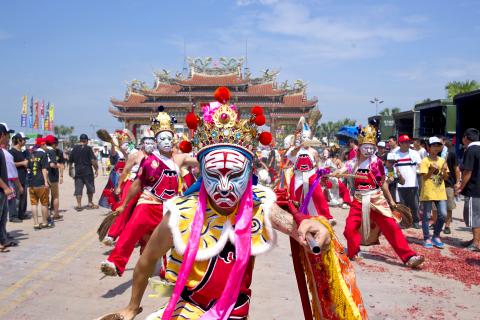
Photo: Noah Buchan, Taipei Times
And judging by the tens of thousands of pilgrims and tourists who have shown up to Nankunshen’s temple festival on this Sunday in late May, the deity isn’t the only one being appeased.
“Those girls are hot,” says a photographer surnamed Liu (劉) when asked why she’s photographing the dancers. “They’ll attract attention to my blog,” she adds.
Ceremonial troupes such as the one Liu is avidly photographing, and the branch temples that send them to temple festivals, are at the root of the enormous growth in folk religious participation that has occurred over the past decade in Taiwan.
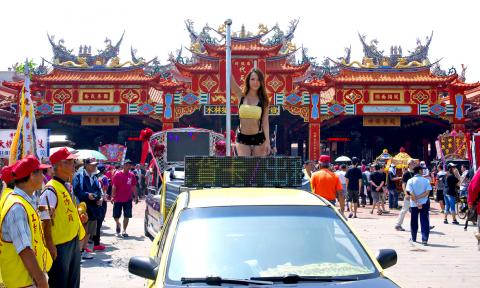
Photo: Noah Buchan, Taipei Times
Hou Hsian-hsun (侯賢遜), Nankunshen’s secretary-general, says temple festivals are no longer just about religious worship. Quoting Tourism Bureau figures, he says that of the 10 million visitors per year to the temple, three million are tourists who have come to see what he calls a “living museum” of folk religion.
“We are a conglomerate of historical heritage, art and relics, as well as a tourist hotspot,” Hou tells the Taipei Times beneath a bas-relief mural of heroes — both mythological and real, Chinese and Taiwanese — within the peaceful courtyard of a recent temple extension.
He adds, with obvious pride, that “Nankunshen Daitianfu is in a leading position” among Taiwan’s folk temples because of its long history and its astonishing number of branch temples.
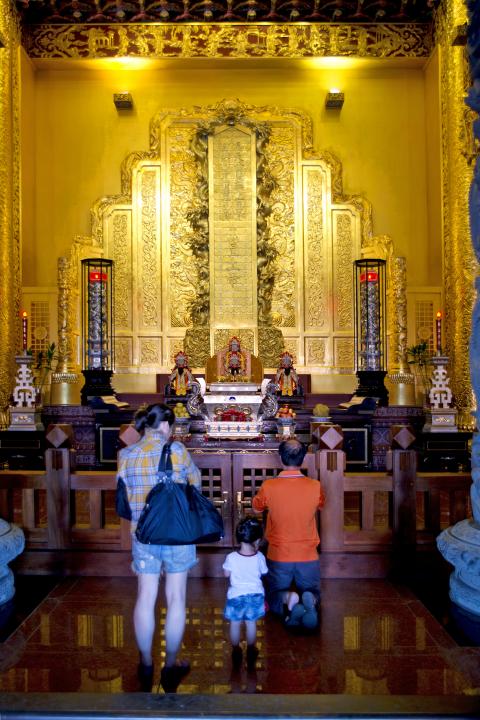
Photo: Noah Buchan, Taipei Times
Like most temple leaders, Hou’s talk of folk worship is spoken in the idiom of the superlative corporate sales pitch.
“Nankunshen’s branch temples number 21,311, making up roughly half of the 43,000 temples in Taiwan,” he says, adding that that number includes branches of branches.
It’s a number that’s impossible to verify because many of these branch temples will not be officially registered (Wangye specialists put the number of registered Royal Lords’ temples at around 1,000, though this excludes the vast number of private temples and tiny altars erected to worship the cult).
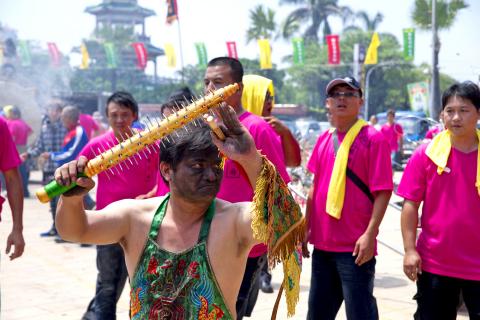
Photo: Noah Buchan, Taipei Times
Still, that’s a lot of yearly reports — and a lot of ceremonial parade troupes making them.
BRANCHING OUT
The branch temple phenomena dates back to before Han Chinese began to migrate to Taiwan — a place regarded as a wild frontier — in the Ming Dynasty. They brought with them deities that were enshrined in temples, which gradually became village centers of economic activity, worship and protection from entities real (other humans) and imagined (ghosts).
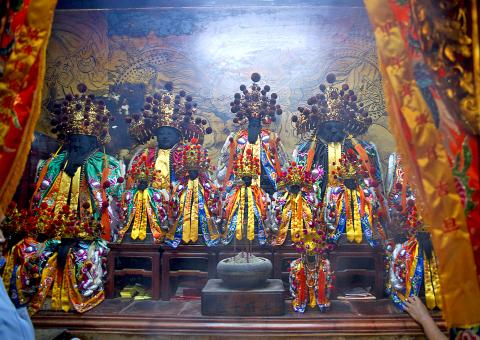
Photo: Noah Buchan, Taipei Times
On its own, a wooden sculpture of a deity possesses no magic and so cannot provide worshippers with any kind of protection. It only gains this kind of power when it is ritually passed over the main incense burner of an established temple, a ceremony known as dividing incense (分香). The consecrated deity, along with ashes from the senior temple’s incense burner, is then enshrined in a newly established temple, known as a branch temple (分廟).
The branch temple enters into a subordinate relationship, obliging it to return the newly empowered deity, usually carried at the front of a ceremonial troupe, to the source temple on the deity’s birthday to recharge its power.
Hou says that worshippers are motivated to establish a branch temple of Nankunshen because it is Taiwan’s oldest Wangye temple, a history that began 353 years ago when a ship sailing from China ran aground during a storm off the coast of Beimen.
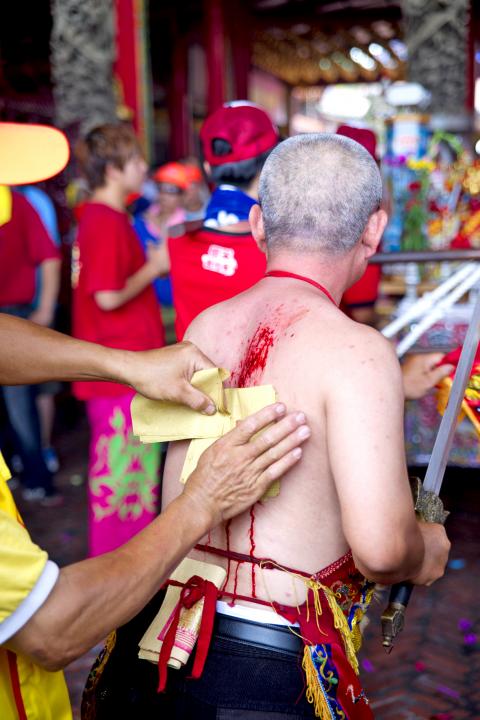
Photo: Noah Buchan, Taipei Times
Five statues, all avatars of Wangye (folk religion specialists estimate that there are over 100 manifestations of this deity), were retrieved from the wrecked ship and brought to shore. Nankunshen is a rare exception to a general rule that Taiwan’s temples have branched off from temples in China.
Nankunshen isn’t the only temple franchising out as though a 7-Eleven of folk belief. All of Taiwan’s older temples, regardless of their patron deity — Matsu (媽祖), the Earth God (土地公), Baoshengdadi (保生大帝) or Wangye — have branch temples that are expected to send a ceremonial troupe to perform at temple festivals on that particular god’s birthday.
Today, temples large and small, rural and urban have opened their gates to anyone curious enough to show up for a festival, adapting their rituals to changing social and technological trends that appeal to the media, tourists, politicians and government officials, while retaining enough of their traditions to maintain their core believers.
As a result, temples have become wealthy and powerful.
POWER
Women gyrating in skimpy outfits and self-flagellating men aren’t the kinds of activities that government officials typically want to be associated with. Indeed, officials were once embarrassed by Taiwan’s folk religion, generally viewing it as a superstitious and lawless holdover of an agricultural past — an ideological position dating back to the era of the scholar officials when there was a separation between the imperially sanctioned centers of worship and folk heterodox beliefs.
No longer. When looking for votes, politicians at the grassroots, city and county level include temples on the stump. And as Taiwan has developed a greater sense of its identity, government officials have been keen to promote temples as Taiwan’s cultural heritage because it can lift its nose at China while bringing in tourist dollars from that country.
On the Sunday of Wangye’s birthday, Greater Tainan Mayor William Lai (賴清德) and Taiwan’s culture minister Lung Ying-tai (龍應台) presented a certificate recognizing Nankunshen’s four pilgrimage events as important national folk customs (國家重要民俗).
Sounding every bit the sales person as Hou, Lung said that aside from Beigang’s (北港) Chaotian Temple (朝天宮), Nankunshen is the only national historical monument (國定古蹟) to folk religion. And, she added, it was 32 years older than its counterpart.
“So we can truly say that [Nankunshen] is a national treasure,” she said.
Words and deeds like these help boost Nankunshen’s national profile — and its own treasure.
WEALTH
For Taiwan’s popular religion, wealth and ritual are inextricably linked, and folk temples in Taiwan are big business. The greater a temple’s conspicuous display of wealth, the thinking goes, the more efficacious it will be in granting worshippers their desires.
The same logic applies to the ceremonial troupes that branch temples parade to temple festivals, making them ever-fiercer competitions of extravagant display. The makeup of the eight generals must appear as though it has been applied by an artist, their dance moves as intricately choreographed as the pole dancers, whose outfits have become noticeably skimpier with every passing year. Every troupe performs for the god amidst raucous firecracker displays.
(Incidentally, it’s common for these troupes to spin their ceremonial troupes off into careers, performing at fundraisers, banquets and weddings. One of the pole-dancing troupes has its own Facebook account, plenty of fans and offers classes. The same holds true for lion and dragon dancers — though one can imagine that a self-goring entranced spirit medium probably won’t be invited to perform at that corporate luncheon.)
These lavish displays show respect to the source temple, while revealing that the branch temple too has wealth and resources — resources that Nankunshen clearly benefits from.
Hou says that Nankunshen recently installed a 6.6m tall, solid gold stele weighing 405kg with an estimated price tag of NT$600 million (US$20.6 million), while the recently finished temple extension where it is located took 25 years to complete at a cost of NT$2.5 billion, according to reports in the Chinese-language media.
Hou revels in his temple’s crass display of wealth. He mentions a mural that depicts a herd of chubby cows that, for him, symbolizes that Taiwanese “currently lead prosperous lives and have no shortage of material goods.”
It’s true. A day spent at Nankunshen might cause one to forget that wages have stagnated over the same time that Taiwan’s folk religion has boomed.
MAINTAINING POWER
Sometimes the symbiotic relationship between source and branch temples can unravel into bickering over temple provenance.
A six-decade feud had existed between Beigang’s Chaotian Temple and Fongtian Temple (奉天宮), first built in 1700 and located a 10-minute drive away in Singang Township (新港), over claims that each represents the most direct ritual connection to, or branch of, what is believed to be the original Matsu temple in China.
The schism became national public consumption when Jhenlan Temple (鎮瀾宮), a wealthy temple in Greater Taichung’s Dajia District (大甲), welcomed a new Matsu statue in the late 1980s from the original temple in China.
This effectively called into question its subordinate position to Chaotian Temple, its putative source temple. Jhenlan soon switched its annual Dajia Matsu Pilgrimage (大甲媽祖繞境進香) from Beigang to Singang, enabling it to show its power, increase its wealth and bring wealth to Singang’s Fongtian Temple.
Branch temples can have as much power as their corporate ones, if their leaders are cunning and know how to bring media attention to its parades.
Today, Jhenlan’s 10-day pilgrimage, a 340km route that meanders through rural central Taiwan to Singang and back to Dajia, attracts over a million pilgrims, Matsu believers, tourists and the curious, according to Chinese-language media. And in the words of President Ma Ying-jeou (馬英九), it is the “world’s third-largest pilgrimage.”
Though Beigang remains a popular and important center of folk worship, attention has shifted over the past years as Singang has thrived.
GOING GLOBAL
Local temples have not only branched out as multiregional centers of folk worship, but increasingly internationally in a sacramental line linking them back to Taiwan.
Back in Nankunshen, Kuo Wen-chen (郭玟成), a former DPP legislator, shows me around the temple’s congested inner courtyard where the five original Wangye statues reside.
The gates leading into the courtyard are protected by burly men dressed in yellow t-shirts with Nankunshen insignia. The gates are cordoned off and restricted to everyone but a select few who are responsible for ritually passing branch deities in front of the Wangye avatars, ceremonially recharging their power before being returned to the troupes who had just handed them over for the purpose.
Kuo draws my attention to several tables topped with hundreds of Wangye deities that have been returned to Nankunshen by temples from throughout Taiwan and Southeast Asia.
“These deities have traveled a long way from Thailand. Wangye will recharge them and provide protection for those worshipping at that temple,” Kuo says.
Hou says Nankunshen’s first international branch temple was founded in Thailand 33 years ago by an overseas Taiwanese businessman.
Since then, Wangye has been franchised out to Malaysia, Singapore and, in a reversal of a centuries-old tradition, China.
“The number of Taiwanese businessmen asking us to establish branch temples in China is growing,” Hou says.
As most of China’s temples were destroyed during the Cultural Revolution and their incense burners extinguished, Taiwan’s temples might be the only authentic source of a folk tradition dating back millennia that, although has gradually been revived over the past few decades in China, remains true to its roots in Taiwan.
Hou welcomes the renewal of folk religion in China, trusting that increasing numbers of overseas Taiwanese and eventually Chinese will open up branch temples of Nankunshen.
“After all, deities are not separated by national borders,” Hou says.
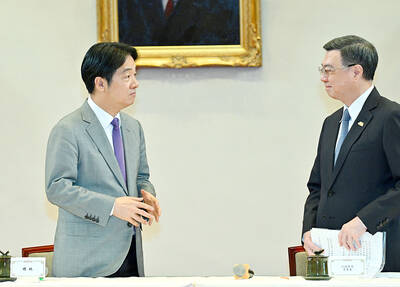
Under pressure, President William Lai (賴清德) has enacted his first cabinet reshuffle. Whether it will be enough to staunch the bleeding remains to be seen. Cabinet members in the Executive Yuan almost always end up as sacrificial lambs, especially those appointed early in a president’s term. When presidents are under pressure, the cabinet is reshuffled. This is not unique to any party or president; this is the custom. This is the case in many democracies, especially parliamentary ones. In Taiwan, constitutionally the president presides over the heads of the five branches of government, each of which is confusingly translated as “president”
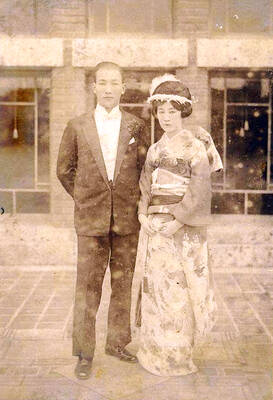
Sept. 1 to Sept. 7 In 1899, Kozaburo Hirai became the first documented Japanese to wed a Taiwanese under colonial rule. The soldier was partly motivated by the government’s policy of assimilating the Taiwanese population through intermarriage. While his friends and family disapproved and even mocked him, the marriage endured. By 1930, when his story appeared in Tales of Virtuous Deeds in Taiwan, Hirai had settled in his wife’s rural Changhua hometown, farming the land and integrating into local society. Similarly, Aiko Fujii, who married into the prominent Wufeng Lin Family (霧峰林家) in 1927, quickly learned Hoklo (commonly known as Taiwanese) and

The Venice Film Festival kicked off with the world premiere of Paolo Sorrentino’s La Grazia Wednesday night on the Lido. The opening ceremony of the festival also saw Francis Ford Coppola presenting filmmaker Werner Herzog with a lifetime achievement prize. The 82nd edition of the glamorous international film festival is playing host to many Hollywood stars, including George Clooney, Julia Roberts and Dwayne Johnson, and famed auteurs, from Guillermo del Toro to Kathryn Bigelow, who all have films debuting over the next 10 days. The conflict in Gaza has also already been an everpresent topic both outside the festival’s walls, where

The low voter turnout for the referendum on Aug. 23 shows that many Taiwanese are apathetic about nuclear energy, but there are long-term energy stakes involved that the public needs to grasp Taiwan faces an energy trilemma: soaring AI-driven demand, pressure to cut carbon and reliance on fragile fuel imports. But the nuclear referendum on Aug. 23 showed how little this registered with voters, many of whom neither see the long game nor grasp the stakes. Volunteer referendum worker Vivian Chen (陳薇安) put it bluntly: “I’ve seen many people asking what they’re voting for when they arrive to vote. They cast their vote without even doing any research.” Imagine Taiwanese voters invited to a poker table. The bet looked simple — yes or no — yet most never showed. More than two-thirds of those